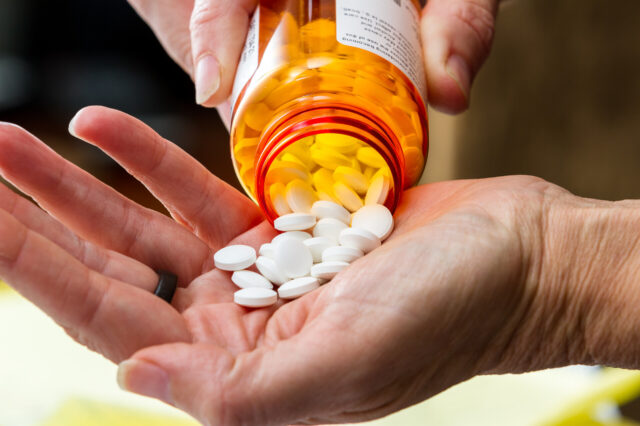Definition
Opiates or opioids are drugs used to treat pain. Opiates are derived from plants and opioids are synthetic drugs that have the same actions as opiates. The term narcotic refers to either type of drug.
If you stop or cut back on these drugs after heavy use for a few weeks or more, you will have a number of symptoms. This is called withdrawal.
Alternative Names
Withdrawal from opioids; Dopesickness; Substance use - opiate withdrawal; Substance abuse - opiate withdrawal; Drug abuse - opiate withdrawal; Narcotic abuse - opiate withdrawal; Methadone - opiate withdrawal; Pain medicines - opiate withdrawal; Heroin abuse - opiate withdrawal; Morphine abuse - opiate withdrawal; Opioid withdrawal; Meperidine - opiate withdrawal; Dilaudid - opiate withdrawal; Oxycodone - opiate withdrawal; Percocet - opiate withdrawal; Oxycontin - opiate withdrawal; Hydrocodone - opiate withdrawal; Detox - opiates; Detoxification - opiates
Causes
In 2018 in the United States, about 808,000 people reported using heroin during the past year. In the same year, about 11.4 million people used narcotic pain relievers without a prescription. Narcotic pain relievers include:
- Codeine
- Heroin
- Hydrocodone (Vicodin)
- Hydromorphone (Dilaudid)
- Methadone
- Meperidine (Demerol)
- Morphine
- Oxycodone (Percocet or Oxycontin)
These drugs can cause physical dependence. This means that a person needs to take the drug to prevent withdrawal symptoms. Over time, more of the drug is needed for the same effect. This is called drug tolerance.
How long it takes to become physically dependent varies with each person.
When the person stops taking the drugs the body needs time to recover. This causes withdrawal symptoms. Withdrawal from opiates can occur any time long-term use is stopped or cut back.
Symptoms
Early symptoms of withdrawal include:
- Agitation
-
Anxiety
-
Muscle aches
-
Increased tearing
-
Insomnia
-
Runny nose
-
Sweating
-
Yawning
Late symptoms of withdrawal include:
-
Abdominal cramping
-
Diarrhea
-
Dilated pupils
-
Goosebumps
-
Nausea
-
Vomiting
These symptoms are very uncomfortable but are not life threatening. Symptoms usually start within 12 hours of last heroin usage and within 30 hours of last methadone exposure.
Exams and Tests
Your health care provider will perform a physical exam and ask questions about your medical history and drug use.
Urine or blood tests to screen for drugs can confirm opiate use.
Other testing will depend on your provider's concern for other problems. Tests may include:
- Blood chemistries and liver function tests such as CHEM-20
- CBC (complete blood count, measures red and white blood cells, and platelets, which help blood to clot)
- Chest x-ray
- ECG (electrocardiogram, or heart tracing)
- Testing for hepatitis C, HIV, and tuberculosis (TB), as many people who use opiates also have these diseases
Treatment
Withdrawal from these drugs on your own can be very hard and may be dangerous. Treatment most often involves medicines, counseling, and support. You and your provider will discuss your care and treatment goals.
Withdrawal can take place in a number of settings:
- At-home, using medicines and a strong support system. (This method is difficult, and withdrawal should be done very slowly.)
- Using facilities set up to help people with detoxification (detox).
- In a regular hospital, if symptoms are severe.
MEDICINES
Methadone relieves withdrawal symptoms and helps with detox. It is also used as a long-term maintenance medicine for opioid dependence. After a period of maintenance, the dose may be decreased slowly over a long time. This helps reduce the intensity of withdrawal symptoms. Some people stay on methadone for years.
Buprenorphine (Subutex) treats withdrawal from opiates, and it can shorten the length of detox. It may also be used for long-term maintenance, like methadone. Buprenorphine is often combined with Naloxone (Bunavail, Suboxone, Zubsolv), which helps prevent dependence and misuse.
Clonidine is used to help reduce anxiety, agitation, muscle aches, sweating, runny nose, and cramping that are due to withdrawal. It does not help reduce cravings.
Other medicines can:
- Treat vomiting and diarrhea
- Help with sleep
Naltrexone can help prevent relapse. It is available in pill form or as an injection. It also, however, can bring about a sudden and severe withdrawal if taken while opioids are still in your system.
People who go through withdrawal over and over should be treated with long-term methadone or buprenorphine maintenance.
Most people need long-term treatment after detox. This can include:
- Self-help groups, like Narcotics Anonymous or SMART Recovery
- Outpatient counseling
- Intensive outpatient treatment (day hospitalization)
- Inpatient treatment
Anyone going through detox for opiates should be checked for depression and other mental illnesses. Treating these disorders can reduce the risk for relapse. Antidepressant medicines should be given as needed.
Support Groups
Support groups, such as Narcotics Anonymous and SMART Recovery, can be enormously helpful to people addicted to opiates:
Outlook (Prognosis)
Withdrawal from opiates is painful, but usually not life threatening.
Possible Complications
Complications include vomiting and breathing in stomach contents into the lungs. This is called aspiration, and it can cause lung infection. Vomiting and diarrhea can cause dehydration and body chemical and mineral (electrolyte) disturbances.
The biggest complication is returning to drug use. Most opiate overdose deaths occur in people who have just detoxed. Withdrawal reduces the person's tolerance to the drug, so those who have just gone through withdrawal can overdose on a much smaller dose than they used to take.
When to Contact a Medical Professional
Call your provider if you are using or withdrawing from opiates.
If you or someone you know is thinking about suicide, call or text 988 or chat 988lifeline.org. You can also call 1-800-273-8255 (1-800-273-TALK). The 988 Suicide and Crisis Lifeline provides free and confidential support 24/7, anytime day or night.
You can also call 911 or the local emergency number or go to the hospital emergency room. DO NOT delay.
If someone you know has attempted suicide, call 911 or the local emergency number right away. DO NOT leave the person alone, even after you have called for help.
References
Kampman K, Jarvis M. American Society of Addiction Medicine (ASAM) National Practice Guideline for the use of medications in the treatment of addiction involving opioid use. J Addict Med. 2015;9(5):358-367. PMID: 26406300 pubmed.ncbi.nlm.nih.gov/26406300/.
Nikolaides JK, Thompson TM. Opioids. In: Walls RM, Hockberger RS, Gausche-Hill M, eds. Rosen’s Emergency Medicine: Concepts and Clinical Practice. 10th ed. Philadelphia, PA: Elsevier; 2023:chap 151.
Ritter JM, Flower R, Henderson G, Loke YK, MacEwan D, Rang HP. Drug abuse and dependence. In: Ritter JM, Flower R, Henderson G, Loke YK, MacEwan D, Rang HP, eds. Rang and Dale's Pharmacology. Philadelphia, PA: Elsevier; 2020:chap 50.
Substance Abuse and Mental Health Services Administration. Key substance use and mental health indicators in the United States: Results from the 2020 National Survey on Drug Use and Health. www.samhsa.gov/data/sites/default/files/reports/rpt35325/NSDUHFFRPDFWHTMLFiles2020/2020NSDUHFFR1PDFW102121.pdf. Updated October 2021. Accessed September 23, 2022.
Last reviewed April 30, 2022 by Fred K. Berger, MD, addiction and forensic psychiatrist, Scripps Memorial Hospital, La Jolla, CA. Also reviewed by David C. Dugdale, MD, Medical Director, Brenda Conaway, Editorial Director, and the A.D.A.M. Editorial team..


